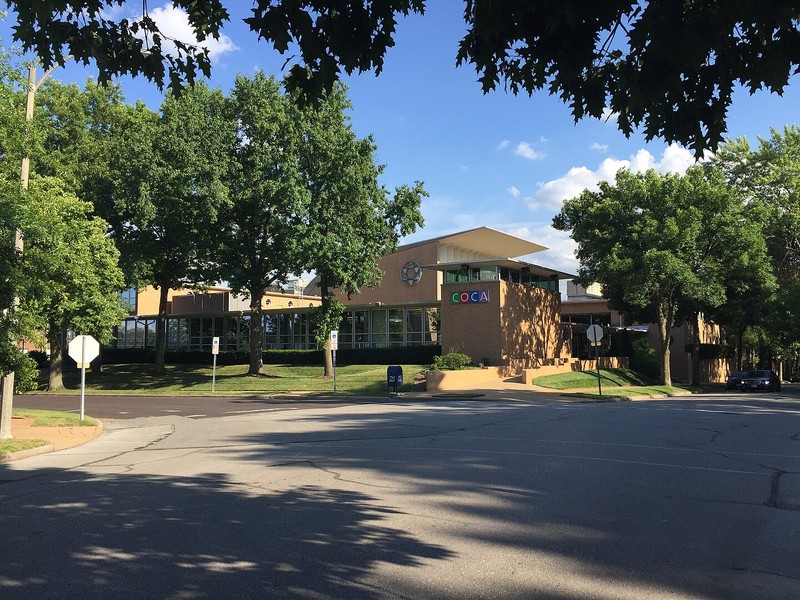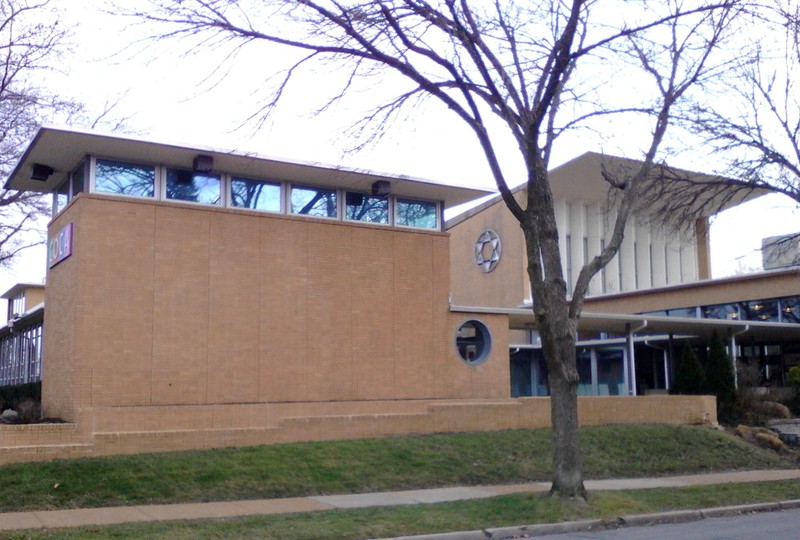Congregation B'Nai Amoona Synagogue (Center of Contemporary Arts)
Introduction
Text-to-speech Audio
Construction on the Congregation B'nai Amoona synagogue started in 1948 and was completed in 1950. The Jewish community for which Congregation B'nai Amoona serves dates back to the 1880s, and it has strong ties to Jews that arrived in the nineteenth century from Kracow, then a Russian city and now part of Poland. The building differed from many traditionally-designed synagogues, exuding modern-movement characteristics and much-improved functionality. Eric Mendelsohn, an acclaimed and accomplished architect who, as a German Jew, fled Nazi Germany in the early 1930s, designed the building and deemed it one of his best works.
Images
Congregation B'Nai Amoona Synagogue

Congregation B'Nai Amoona Synagogue

Backstory and Context
Text-to-speech Audio
Shortly after the Civil War, numerous German Jews resided in St. Louis and formed an Orthodox congregation called Sheerith Israel ("Remnant of Israel"). Adhering to conventional Jewish values, the congregation eventually became St. Louis' largest of its kind. By the 1880s, numerous members grew dissatisfied with the strictness of Orthodoxy. As a result, they left to form a new branch known as "B'nai Amoona," which means "Children of Faith." Immigrants from Russian Kracow, which now exists as part of Poland. Sheerith Israel disbanded by the turn of the twentieth century, so B'nai Amoona absorbed most of its members and evolved into one of the Midwest's largest Jewish Conservative communities.
The synagogue serves as a monument to the work and story of Eric Mendelsohn, a Jewish German immigrant who fled Nazi Germany and designed the Congregation B'nai Amoona after World War II. Mendelsohn (1887 - 1953) was born in East Prussia and studied economics at the University of Munich, architecture at the Technical University of Berlin, and then architecture at the Technical University of Munich, where in 1912, he graduated cum laude. From 1912 to 1914, he worked as an independent architect in Munich. In 1915 he partnered with Herbert Freundlich, deputy director of the modern-day Fritz Haber Institute of the Max Planck Society in Berlin, to design and build the Einsteinturm ("Einstein Tower"), an astronomical observatory suitable to experimentally confirm Einstein's Theory of Relativity.
Despite developing a thriving architecture practice after World War I (employing as many as forty people), as a Jew, witnessing the rise of antisemitism in Germany, he emigrated to England in 1933. Nazi Germany later seized Mendelsohn's fortune, removed him from the German Architects' Union, and excluded him from the Prussian Academy of Arts. While in England, he began working in Isreal (under British rule) and proved highly influential in the local Jerusalem International Style with facades fashioned in limestone. Mendelsohn immigrated to the U.S. during World War II, either in 1941 or 1942 (sources differ), where he soon collaborated with the U.S. Army to build replica German villages that helped the military carry out the firebombings on Berlin. The Congregation B'nai Amoona synagogue was Mendelsohn's first completed independent project in the U.S., but his career blossomed as one of the modernism movement's most influential figures.
After the war, Mendelsohn began to acquire commissions for synagogues, with the Congregation B'nai Amoona in St. Louis in 1945 serving as his first independent project. His desire to employ a more modern approach to synagogue designs converged with America's post-war society as young adults, including those within the American Jewish community, began to disperse to an expanding array of suburban towns. Moreover, the horrors of the Holocaust, World War II, and other memories of traditional European Judaism inspired Jewish congregations in new communities to "start fresh," which included synagogues designed with modern designs, making Mendelsohn an attractive architect for Jewish Americans in the 1940s.
The Congregation B'nai Amoona in University City was the nation's first synagogue to break significantly from the Moorish and Byzantine architectural styles that dominated synagogue designs for decades, if not longer. Additionally, because Jewish congregations experience a drastic fluctuation in attendance, with much higher attendance during high holidays than an average sabbath, Mendelsohn devised a "flexible plan" design that consisted of movable doors between the sanctuary and lower spaces, which allowed capacity to expand from 600 to 1,500; a revolutionary design at the time that's now standard. Thus, the construction of Congregation B'nai Amoona, both in terms of its aesthetic and functional design, ushered in a new era in synagogue architecture.
Sources
"Congregation B'nai Amoona." St. Louis Genealogical Society. 2017. https://stlgs.org/research-2/congregations/jewish/jewish-synagogues-and-temples/congregation-bnai-amoona.
"Erich Mendelsoh." Architectuul. Accessed May 29, 2023. https://architectuul.com/architect/erich-mendelsohn.
Grove, Carol "Center of Contemporary Arts." Society of Architectural Historians (SAH Archipedia). May 2023. http://sah-archipedia.org/buildings/MO-01-189-0001.
Schroeder, Ivy. "Architect of Form and Spirit: Eric Mendelsohn Center of Contemporary Arts." Riverfront Times. October 11, 2000. https://www.riverfronttimes.com/arts/architect-of-form-and-spirit-eric-mendelsohn-2473146.
Soren, L. Noelle. "Nomination Form: Congregation B'nai Amoona." National Register of Historic Places. mostateparks.com. 1984. https://mostateparks.com/sites/mostateparks/files/B%27Nai%20Amoona%20Synogogue.pdf.
"St. Louis, MO: Congregation B'Nai Amoona (1950)." Synagogues of the South. Accessed May 29, 2023. https://synagoguesofthesouth.cofc.edu/synagogues/st-louis-mo-congregation-bnai-amoona-1950/.
By LittleT889 - Own work, CC BY-SA 4.0, https://commons.wikimedia.org/w/index.php?curid=61043190
Cole Woodcox, SAH Archipedia, https://sah-archipedia.org/buildings/MO-01-189-0001
